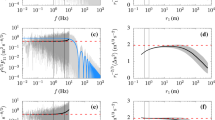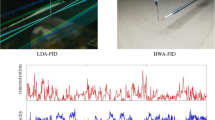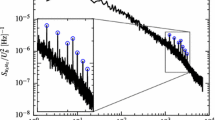Abstract
In this paper, a model of the measuring process of sonic anemometers with more than one measuring path is presented. The main hypothesis of the work is that the time variation of the turbulent speed field during the sequence of pulses that produces a measure of the wind speed vector affects the measurement. Therefore, the previously considered frozen flow, or instantaneous averaging, condition is relaxed. This time variation, quantified by the mean Mach number of the flow and the time delay between consecutive pulses firings, in combination with both the full geometry of sensors (acoustic path location and orientation) and the incidence angles of the mean with speed vector, give rise to significant errors in the measurement of turbulence which are not considered by models based on the hypothesis of instantaneous line averaging. The additional corrections (relative to the ones proposed by instantaneous line-averaging models) are strongly dependent on the wave number component parallel to the mean wind speed, the time delay between consecutive pulses, the Mach number of the flow, the geometry of the sensor and the incidence angles of mean wind speed vector. Kaimal´s limit k W1=1/l (where k W1 is the wave number component parallel to mean wind speed and l is the path length) for the maximum wave numbers from which the sonic process affects the measurement of turbulence is here generalized as k W1=C l /l, where C l is usually lesser than unity and depends on all the new parameters taken into account by the present model.








Similar content being viewed by others
Abbreviations
- a jr :
-
components of matrix [A]
- c :
-
sound speed, m/s
- C d :
-
dimensionless wave number associated with distances between path midpoints
- C l :
-
dimensionless wave number associated with path length
- \( c_{xy}^{XY} \) :
-
components of matrix [C XY]; XY≡AW, PA, PW, WP; xy≡aj, sa, sj, js
- [C AW ] :
-
AW ]anemometer system–wind system transformation matrix
- [C PW ] :
- dk ⊥ :
-
⊥dk W2 dk W3, m–2
- dp :
-
differential displacement of a pulse along a generic acoustic path, m
- {d Ψ}:
-
Ψ}vector configured by three orthogonal increments dψ j (j=1,2,3), m/s
- e A a :
-
vectors defining the anemometer system (a=1,2,3)
- e P s :
-
unit path vector; this vector defines the direction of an acoustic path (s=1,2,3)
- e W j :
-
vectors defining the wind system (j=1,2,3)
- E(k):
-
k)turbulence three-dimensional energy spectrum, m3/s–2
- f :
-
frequency of turbulent wind speed, Hz
- f 0 :
-
effective data delivering frequency, Hz
- \( U_p ^i (t) = \left[ {\matrix{ 1 & 0 & 0 & 0 & 0 \cr 0 & 1 & 0 & 0 & 0 \cr 0 & 0 & 1 & 0 & 0 \cr 0 & 0 & 0 & 1 & 0 \cr 0 & 0 & 0 & 0 & 1 \cr } } \right] \) :
-
dimensionless Lagrangian average of fluctuation velocity along path s, associated with the pulse travelling in direction ± (see Eq. (24)
- F j :
-
spectral density function at one point, corresponding to fluctuation components jt of wind speed vector, m3/s2
- \( F_{jt}^M \) :
-
measured spectral density function at one point, corresponding to fluctuation components jt of wind speed vector, m3/s2
- g :
-
acceleration of gravity vector, m/s2
- \( G_s^ \pm \) :
-
function defined by Eq. 31
- k :
-
wave number vector, m–1
- k Wj :
-
j component of wave number vector expressed in the wind system, m–1
- k Aa :
-
a component of wave number vector expressed in the anemometer system, m–1
- k ⊥ :
-
{k W2,k W3}, m–1
- l :
-
acoustic path length, m
- l P s :
-
acoustic path vector (direction and modulus of acoustic path s, direction+coincident with the direction of the first firing), m
- l Ps :
-
length of acoustic path s, m
- l w :
-
representative length scale of wind speed variations associated with shear, surface blockage or thermal effects, m
- M ∞ :
-
Mach number of atmospheric flow related to mean wind speed vector modulus ∣u ∞∣
- MUSA 1:
-
METEK USA 1 sonic anemometer model
- n 0 :
-
number of measurements averaged in a final output
- p :
-
pulse position on the acoustic path related to path origin, m
- \( p_{0s}^ \pm \) :
-
acoustic path extremes of a generic path s, m
- P :
-
dimensionless pulse position on the acoustic path related to path origin
- \( P_0^ \pm \) :
-
dimensionless acoustic path extremes of a generic path s
- q sj :
-
see Eq. (35) )
- Q s :
-
0.5(G + s +G – s )
- R jt :
-
ratio of measured spectral density function F M jt and the theoretical spectral density function F jt (in this paper, this ratio is referred to as "relation of spectral components")
- ARS:
-
anemometer reference system
- PRS:
-
path reference system
- WRS:
-
wind reference system
- t :
-
time, s
- \( t_s^ \pm \) :
-
time required by an ultrasound pulse front to cover the distance p 0s + to p 0s – (case +) and p 0s – to p 0s + (case –) of a generic acoustic path s, s
- \( T_s^ \pm \) :
-
dimensionless time required by an ultrasound pulse front to cover the distance P 0s + to P 0s – (case +) and P 0s – to P 0s + (case –) of a generic acoustic path s, s
- \( T_{0s}^ \pm \left( P \right) \) :
-
zero-order estimation of dimensionless time required by an ultrasound acoustic pulse front travelling on the acoustic path s in direction ± to get at point P
- \( T_{1s}^ \pm \left( P \right) \) :
-
first-order estimation of dimensionless time required by an ultrasound acoustic pulse front travelling on the acoustic path s in direction ± to get at point P
- u(x, t):
-
x, t)atmospheric turbulent speed field, m/s
- u Ps :
-
component of wind speed vector parallel to path s, m/s
- u wj :
-
components of wind speed vector expressed in the wind system, m/s
- u– :
-
mean wind speed vector, m/s
- u M :
-
measured wind speed vector, m/s
- \( u_{Wj}^M \) :
-
components of measured wind speed vector expressed in the wind system, m/s
- \( {\bf u}_{\bf S}^{\bf M} ,{\bf u}_{\bf P}^{\bf M} \) :
-
vector formed by components of wind speed vector measured along each acoustic path s, m/s
- \( u_S^M ,u_p^M \) :
-
measurement of the wind speed vector component parallel to a generic acoustic path s, m/s
- û Wj :
-
fluctuation components of the wind speed vector expressed in the wind system, m/s
- û :
-
wind speed fluctuation vector, m/s
- û M :
-
measured wind speed fluctuation vector, m/s
- U Ps :
-
dimensionless speed component along a generic acoustic path s
- \( U_{Ps}^M \) :
-
dimensionless measured speed component along a generic acoustic path s
- \( U_{Wjs}^ \pm \) :
-
dimensionless component of wind speed vector at the ultrasound pulse location (time and point) travelling on the generic acoustic path s in direction ±, respectively
- \( \mathord{\buildrel{\lower3pt\hbox{$\scriptscriptstyle\frown$}}\over U} _{Wjs}^ \pm \) :
-
fluctuation component of \( U_{Wjs}^ \pm \)
- x :
-
location where the wind speed vector is evaluated, m
- x P :
-
geometric center of path midpoints, m
- x A :
-
anemometer system origin, m
- x P s :
-
midpoint of path s, m
- (x A ,e A a ):
-
A ,e A a )anemometer system, m
- (x,e W j ):
-
,e W j )wind system, m
- (x P ,e P s ):
-
P ,e P s )PRS, m
- x Pasa :
-
co-ordinates of the midpoint of a generic acoustic path s expressed in the anemometer system, m
- X :
-
location where the wind speed vector is evaluated, dimensionless
- X P s :
-
dimensionless midpoint of path s
- z B :
-
time delay between two consecutive pulse firings, s
- Z B :
-
dimensionless time delay between two consecutive pulse firings
- α :
-
angle formed by mean wind speed vector and the bisect of the angle formed by the two acoustic paths in Kaimal´s problem, see Fig. 3, rad
- α E :
-
energy spectrum constant
- ε :
-
scale factor of fluctuation speed
- ∈ :
-
viscous dissipation rate of turbulent kinetic energy, m2/s3
- γ As :
-
angle formed by a generic acoustic path s and the plane e A1 –e A2 , rad
- γ AW :
-
Elevation angle of the mean wind speed vector in the anemometer system, rad
- η :
-
Kolmogorof´s length, m
- [Φ]:
-
spectral velocity tensor, m5s–2
- Φ jt (k):
-
(k)jt component of the spectral velocity tensor, m5/s2
- [Φ]M :
-
]Mmeasured spectral velocity tensor, m5/s2
- \( \Phi _{jt}^M \left( {\bf k} \right) \) :
-
measured jt component of the spectral velocity tensor, m5/s2
- λ :
-
l W /l ratio
- θ As :
-
angle between the projection of a generic acoustic path s on the plane e A1 –e A2 and e A1 , rad
- θ AW :
-
azimuth angle of mean wind speed vector in the anemometer system, rad
- θ :
-
half-angle formed by the two paths in the Kaimal´s problem configuration (see Fig. 3), rad
- Ψ j (k,t):
-
(k,t)function with orthogonal increments (homogeneous turbulence model) that define the theoretical fluctuation turbulent wind speed field (j=1,2,3), m/s
- ΨM j (k,t):
-
(k,t)function with orthogonal increments (homogeneous turbulence model) that define the measured fluctuation turbulent wind speed field (j=1,2,3), m/s
References
Batchelor GK (1952) The theory of homogeneous turbulence. Cambridge Monographs on Mechanics and Applied Mathematics
Cuerva A (2001) New models in sonic anemometry. Thesis. Universidad Politécnica de Madrid, ETSI, Aeronauticos, Instituto Universitario Ignacio DaRiva, Madrid
Cuerva A, Sanz-Andrés A (1999) Steps to reach a safe scenario with sonic anemometers as standard sensor for wind measurements in wind energy. European Wind Energy Conference, Risø, EWEA and WIP, Nice. James & James, London, pp 649–652
Cuerva A, Sanz-Andrés A (2000) On sonic anemometer measurement theory. J Wind Eng Ind Aerodyn 88:25–55
Cuerva A, Sanz-Andrés A, Benzdenejnykh N, Perales JM (1998) Assessment of performances of ultrasonic anemometers as one step ahead in wind measurements of energy production of a wind turbine. European Wind Energy Conference, EWEC. R. Watson, Dublin, pp 418–421
Henjes K, Taylor PK, Yelland MJ (1999) Effect of pulse averaging on sonic anemometer spectra. J Atmos Oceanic Technol 16:181–184
Kaimal JC (1978) Sonic anemometer measurement of atmospheric turbulence. In: Dynamic flow conference. Pergamon Press, Oxford, pp 551–565
Kaimal JC, Wyngaard J, Haugen DA (1968) Deriving power spectra from a three-component sonic anemometer. J Appl Meteorol 7:827–837
Kato N, Ohkuma T, Kim JR, Marukawa H, Niihori Y (1992) Full scale measurements of wind velocity in two urban areas using an ultrasonic anemometer. J Wind Eng Ind Aerodyn 41–44:67–68
Lumley JL, Panofsky HA (1964) The structure of atmospheric turbulence. Interscience, New York
Mann J (1994) Models in micrometeorology. Risø, Roskilde, Denmark
Von Kármán T (1958) Progress in the statistical theory of turbulence. Proc Nat Acad Sci USA 34:530–539
Author information
Authors and Affiliations
Corresponding author
Rights and permissions
About this article
Cite this article
Cuerva, A., Sanz-Andrés, A. & Navarro, J. On multiple-path sonic anemometer measurement theory. Exp Fluids 34, 345–357 (2003). https://doi.org/10.1007/s00348-002-0565-x
Received:
Accepted:
Published:
Issue Date:
DOI: https://doi.org/10.1007/s00348-002-0565-x




